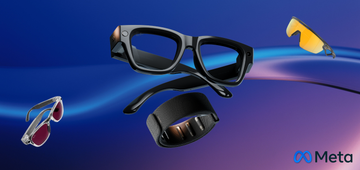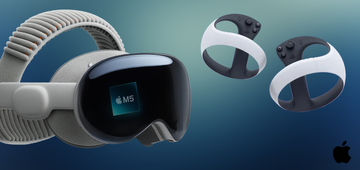Meta Connect 2025: What innovations for virtual reality and smart glasses?
by Mariam Mdoreuli on Oct 03, 2025
Meta Connect , Meta 's annual conference, has become a must-attend event for discovering the latest advances in virtual reality, augmented reality, and artificial intelligence. Each year, the event brings together developers, partners, and industry experts to unveil the group's strategic directions and the innovations that will shape our daily lives.
The 2025 edition marked a major turning point, with strong announcements in the field of immersive technologies , notably the launch of the Meta Ray-Ban Display glasses, integrating a screen and a neural interface. This was a further step towards spatial computing and new human-machine interactions.
Meta Connect 2025: dates and format
Meta Connect 2025 took place on September 17-18, 2025, featuring two days of technical presentations and product demonstrations. This edition marked a strategic turning point with the introduction of consumer neural interfaces and the focus on integrating artificial intelligence across the Meta ecosystem.
The conference combined keynote sessions, technical workshops for developers and demonstrations to test the new devices presented.
Meta's Strategic Vision for 2025
Meta has defined three major strategic axes which guide the development of its products and services:
-
Ergonomic eyewear design
The company aims to develop smart glasses that offer optimal comfort and natural integration into everyday use, moving away from designs perceived as cumbersome or stigmatizing.
-
Preservation of social presence
The devices developed prioritize maintaining natural interactions with the physical environment, with the digital interface fading away when not actively in use.
-
Advanced integration of artificial intelligence
Meta is investing heavily in integrating generative and contextual AI capabilities into its devices, aiming to create intelligent assistants capable of understanding and anticipating user needs.
New generations of smart glasses
Ray-Ban Meta Gen 2: Improved performance
The second generation of Ray-Ban Meta glasses brings significant technical developments:

Technical specifications:
- Video recording in 3K resolution
- Double the battery life compared to the previous generation
- Double video resolution for improved image quality
- Live Meta AI with instant translation and conversational focus mode
- New colors and styles, including limited-edition clear frames
The Conversational Focus System uses advanced audio processing algorithms to isolate and amplify a specific speaker's voice in noisy environments, a technology developed by Meta since 2020.
Pricing: Starting at $379
Oakley Meta Vanguard: performance orientation
Developed in collaboration with Oakley , these glasses specifically target sports and outdoor applications:

Technical characteristics:
- Central camera with 122° viewing angle
- Certified water resistance
- Advanced video stabilization adapted to high-intensity movements
- Enhanced audio system with active wind noise reduction
- Specialized capture modes including slow motion
Partner integrations:
- Garmin: Auto Capture function triggered automatically based on speed, distance or altitude thresholds
- Strava: Sync and display workout stats on recorded videos
Pricing: $499 (expected availability October 21, 2025)
Meta Ray-Ban Display: Introducing the Integrated Display
The Meta Ray-Ban Display represents the major innovation of this edition, integrating for the first time a high-resolution screen in Meta smart glasses :

Viewing device:
- Monocular display (right eye only)
- Slightly off-center positioning to preserve the natural field of vision
- Resolution of 42 pixels per degree
- Maximum brightness of 5000 nits
- Automatic deactivation after a few seconds of inactivity
Meta Neural Band neural interface:
The control system relies on a wristband that detects micro-muscle movements of the wrist via electromyographic (sEMG) sensors. This technology allows for discreet gesture control without visible voice or touch commands.
Bracelet Features:
- 18-hour battery life
- Water resistance
- Accurate gesture intent detection for navigation, photo capture and feature activation
Availability: Initial launch in the United States on September 30, 2025 at $799 , with international rollout planned for later.
Developments in software platforms
Meta Horizon Studio: AI-assisted creation
Horizon Studio is the new PC development environment that integrates a generative AI assistant to accelerate the development of immersive media:
Main features:
- Automatic generation of textures and 3D models via text prompts
- Creation of contextual sound environments
- Automation of common game mechanics
- Simplified creation interface reducing technical barriers
A public beta is planned for the coming months, aiming to democratize content creation for developers and creators without in-depth technical expertise.
Meta Horizon Engine: New Rendering Engine
Meta is gradually replacing Unity with its proprietary Horizon Engine , optimized specifically for the Meta ecosystem:
Technical improvements:
- Environment loading time reduced by 75%
- Increased capacity to over 100 concurrent users per instance
- Improved physics system for more realistic interactions
- Optimized graphics performance across the entire Quest lineup
Horizon Hyperscape: Photorealistic Scanning
Horizon Hyperscape enables the rapid digitization of physical spaces to create photorealistic virtual replicas:
Technical process:
- Space scan lasting a few minutes via Quest 3 or Quest 3S
- Server processing for detailed 3D reconstruction
- Generation of usable environments in virtual reality
Entertainment Partnerships
Horizon TV: video content platform
Meta launches Horizon TV, a centralized hub for the consumption of audiovisual media in virtual reality :
Creative partners:
- Disney+ with access to Hulu and ESPN catalogs
- Universal Studios and Universal Pictures for the cinematic media
- Blumhouse Productions via the Enhanced Cinema app for immersive horror experiences ( M3GAN , The Black Phone )
FAQ
- When will the Meta Ray-Ban Display be available in Europe?
The initial launch of the Meta Ray-Ban Display is scheduled for September 30, 2025, in the United States. Meta has not yet communicated a specific timeline for the European rollout, which is expected to take place in the following months, depending on local certification procedures.
- Are Meta glasses compatible with prescription lenses?
Yes, the entire Ray-Ban Meta range, including the Display, offers optical customization options. Lenses can be adapted to individual prescriptions through Ray-Ban optician partners. Display models also include photochromic lenses that automatically adjust to ambient light.
- How exactly does the Meta Neural Band's neural interface work?
The wristband uses electromyographic (sEMG) sensors that detect electrical signals generated by muscle contractions in the wrist and forearm. These signals are processed by machine learning algorithms to interpret the user's gesture intentions, enabling precise control without visible movements.
- What is the actual autonomy of the different models in professional use?
The Ray-Ban Meta Gen 2 offers twice the battery life of the first generation, allowing for a full day of intermittent use. The Meta Neural Band has a certified battery life of 18 hours of continuous use. Detailed battery life specifications by usage scenario are available in the official technical documentation.
- Is Disney+ support included in the Meta ecosystem?
No, access to Disney+ via Horizon TV requires a separate, active subscription to the Disney+ service. Meta provides the technical infrastructure and streaming platform, but subscriptions to third-party streaming services remain separate and are billed directly by the providers.
- Are Oakley Meta Vanguard goggles suitable for aquatic environments?
Oakley Meta Vanguard lenses are water-resistant, making them suitable for activities involving moisture, rain, or splashes. However, they are not designed for complete immersion in diving or scuba swimming. Precise resistance specifications (IPX standard) will be provided in the final product documentation.
Conclusion
Meta Connect 2025 marked a significant milestone in the evolution of immersive technologies with the introduction of the first consumer-grade projection glasses with a neural interface. These technical advances, combined with enhancements to the Horizon Studio and Horizon Engine software platforms, demonstrate Meta's strategy to democratize access to spatial interfaces.
For professionals and businesses, these innovations open up new perspectives for applications in training, technical assistance, remote collaboration, and the creation of immersive content. The gradual deployment of these technologies over the coming months will allow us to evaluate their adoption in real-world usage contexts.





